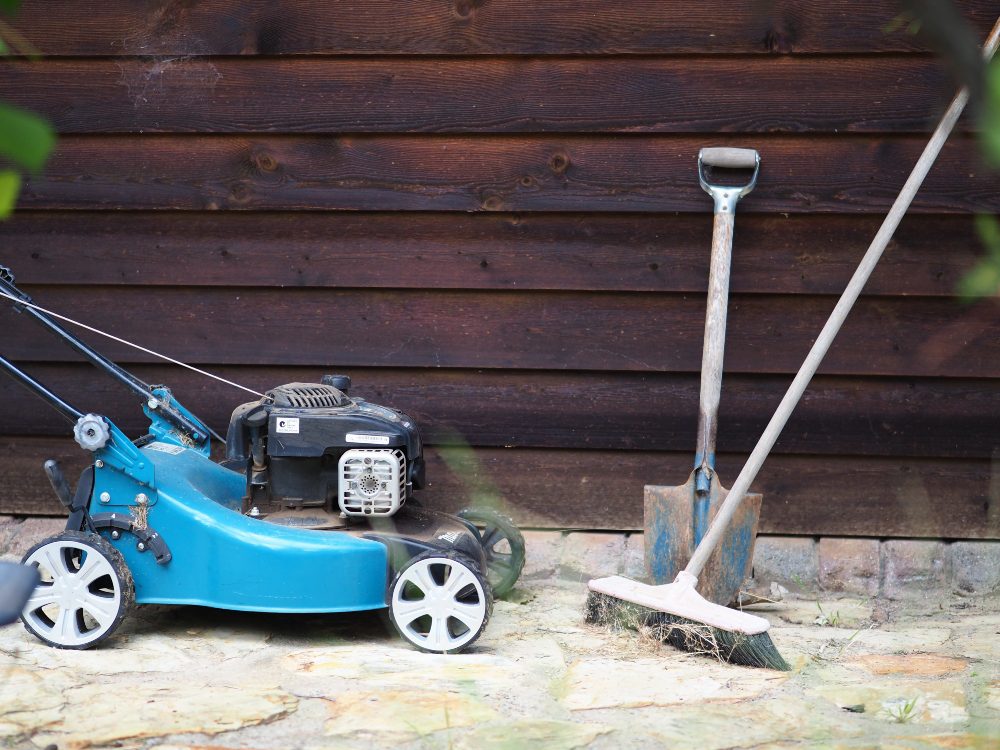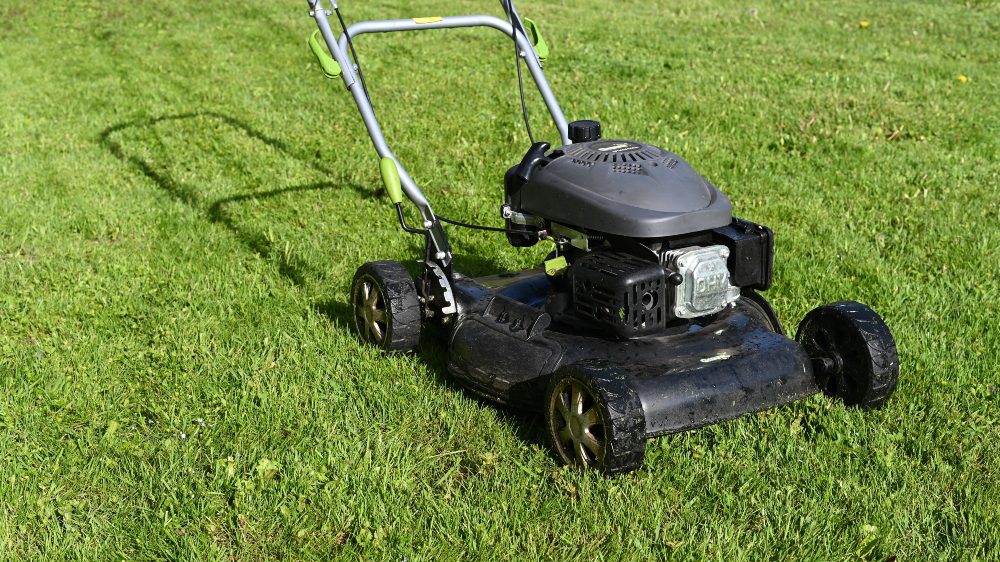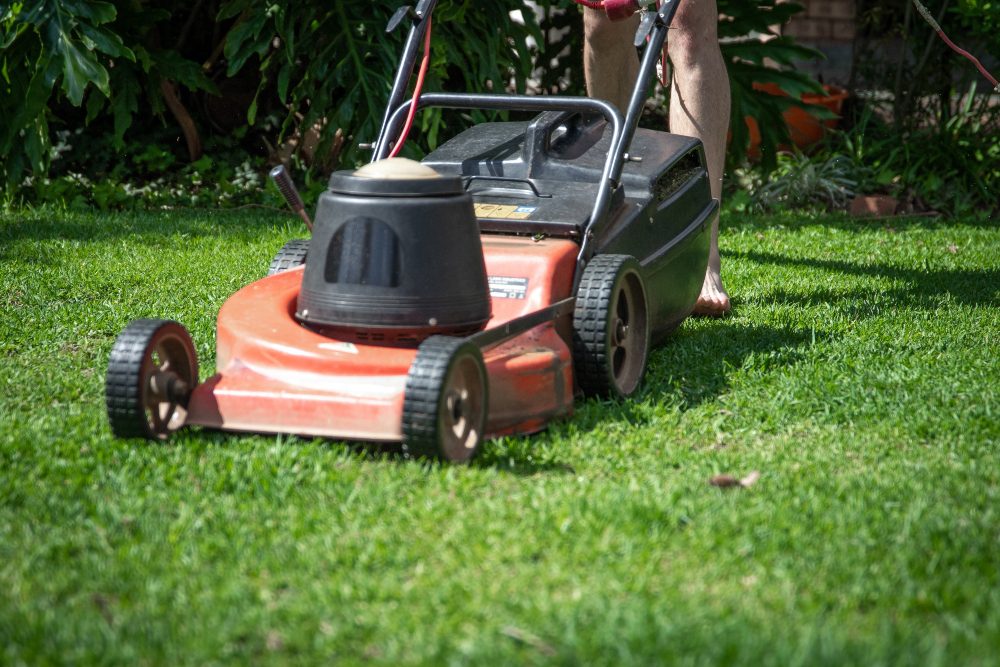
Lawn mower maintenance is the key to keeping your lawn freshly cut. Regular upkeep ensures your mower runs smoothly and efficiently. This article offers essential lawn mower maintenance tips that ensure your machine is cleaned, oiled, and stored properly.
Importance of Lawn Mower Maintenance
Contents
- 1 Importance of Lawn Mower Maintenance
- 2 Lawn Mower Maintenance Tips
- 3 FAQ on Lawn Mower Maintenance
- 3.1 How often should I change the oil in my lawn mower?
- 3.2 Can I sharpen lawn mower blades, or should I get them professionally sharpened?
- 3.3 How important is it to clean the undercarriage of my lawn mower?
- 3.4 What kind of oil should I use for my lawn mower?
- 3.5 How do I know when to replace my lawn mower’s air filter?
- 3.6 Is it necessary to use a fuel stabilizer in my lawn mower?
- 3.7 How should I store my electric lawn mower’s battery over the winter?
- 3.8 Why is it important to check the spark plug in lawn mower maintenance?
- 3.9 How do I prepare my lawn mower for the different seasons?
- 3.10 Can I leave gasoline in my lawn mower over winter?
- 4 Conclusion
Proper lawn mower maintenance is essential for any homeowner or gardener. It ensures your mower functions at its best, providing a clean, even cut every time. This section shows you why maintaining your lawn mower is so crucial.
Impact on Performance and Longevity
Regular maintenance is key in optimizing your lawn mower’s performance and extending its service life. When you keep up with lawn mower maintenance, you ensure the machine operates at its peak. This leads to a more efficient grass-cutting process, characterized by cleaner cuts and reduced strain on the mower’s engine.
A well-maintained lawn mower performs better and experiences fewer mechanical issues. This is crucial because frequent breakdowns can be costly and time-consuming. For instance, a dull blade requires the engine to work harder, increasing wear and tear. Regularly sharpening the blade, therefore, preserves the engine’s longevity.
Moreover, regular maintenance helps identify potential problems early. Addressing issues like clogged filters or worn-out spark plugs before they escalate can prevent more significant, expensive repairs. Maintaining your lawn mower avoids the inconvenience and cost of unexpected breakdowns.
Safety Considerations
Ensuring the safety of your lawn mower through regular maintenance is as crucial as maintaining its performance. A mower in good condition is less likely to cause accidents or injuries. This aspect of lawn mower maintenance is often overlooked, but it is essential for safe operation.
Loose or damaged parts on a lawn mower can be hazardous. For example, a loose blade can become a dangerous projectile. Regular checks help identify and secure loose components, reducing the risk of them detaching or malfunctioning during use.
Similarly, damaged parts, such as cracked wheels or handles, can lead to accidents. Regular inspections and timely replacements of such parts are vital for safe operation.
Dull blades affect the mower’s performance and pose a safety risk. They require the mower to exert more force, which can lead to unexpected behavior or loss of control.
Sharp blades ensure a clean cut and more predictable, safer operation. Regularly sharpening the blades is an important part of lawn mower maintenance for performance and safety.
Clogged filters are another concern. They can cause the engine to overheat, which might lead to a fire hazard. Keeping the air and fuel filters clean ensures the engine runs smoothly and safely.
Lawn Mower Maintenance Tips
Full lawn mower maintenance involves giving different parts of the machine your attention. Below are maintenance tips and guides to keep your lawn mower cutting grass efficiently for a long time.
Regular Cleaning and Inspection
Maintaining your lawn mower involves more than occasional check-ups; it requires regular cleaning and inspection. This practice is essential for effective lawn mower maintenance, ensuring your mower remains in optimal condition for each use.
Steps for Cleaning Your Lawn Mower
- Exterior Cleaning: Clean any grass, dirt, and other gun beneath your machine. Use a brush or cloth to clean the mower’s body and a hose to remove any stuck-on grass. Ensure the mower is dry before storing it.
- Undercarriage Cleaning: The undercarriage often accumulates grass clippings that can clog the discharge chute. Use a putty knife or similar tool to scrape off this build-up. This step is crucial for maintaining airflow and cutting efficiency.
- Blade Cleaning: Clean the blades regularly to remove any stuck-on grass or debris. This not only improves cutting efficiency but also prevents rust and corrosion.
Key Components to Inspect Regularly
- Blades: Regularly inspect the blades for dullness and damage. Sharp, undamaged blades are essential for an even cut and safe operation.
- Engine Oil: Check the oil level before each use. Low or dirty oil can lead to engine problems. Change the oil as recommended by the manufacturer.
- Air Filter: A clean air filter is vital for the engine’s performance. Inspect it regularly and replace it when it becomes dirty or clogged.
- Fuel System: Check for any leaks in the fuel system. Old or contaminated fuel can cause engine problems, so it’s important to use fresh fuel and clean the fuel filter regularly.
- Tires: Ensure the tires are properly inflated and inspect them for wear and tear. Properly maintained tires provide stability and better control of the mower.
- Spark Plug: A dirty or faulty spark plug can affect engine performance. Check and replace the spark plug as needed to ensure efficient operation.

Regular cleaning and inspection are the cornerstones of effective lawn mower maintenance. They not only prolong the life of your mower but also ensure it operates safely and efficiently. By following these steps, you can keep your lawn mower in top condition, ready to tackle your lawn with each use.
Blade Maintenance
Blade maintenance is a critical aspect of lawn mower maintenance. It directly influences the mower’s cutting efficiency and overall performance. Properly maintained blades ensure a clean and even cut, reducing the stress on the mower’s engine.
When and How to Sharpen Lawn Mower Blades
- Frequency of Sharpening: Lawn mower blades typically need sharpening after every 20 to 25 hours of use. However, this can vary based on the mower’s usage and the type of grass being cut.
- Sharpening Process: To sharpen the blades, disconnect the spark plug wire first to ensure safety. Remove the blades following the manufacturer’s instructions. Use a file or a blade sharpening tool to sharpen the edges. Maintaining the blade’s balance: an unbalanced blade can cause vibrations and damage the mower.
- Professional Sharpening: If you’re uncomfortable sharpening the blades, consider taking them to a professional. They have the right tools and expertise to do the job correctly.
Replacing Blades
- Recognizing Wear and Damage: If blades are bent, deeply nicked, or too worn, sharpening won’t suffice. In such cases, blade replacement is necessary.
- Choosing the Right Blades: When replacing blades, ensure they are the correct type and size for your mower. Using the wrong blades can be dangerous and affect the mower’s performance.
- Installation: Installing new blades is relatively straightforward, but it must be done carefully. Ensure they are securely fastened and properly aligned. Again, if unsure, seek professional help.
Engine Care and Maintenance
Engine care is a vital part of lawn mower maintenance. It ensures your lawn mower operates efficiently and has a long lifespan.

Regular Oil Changes and Engine Checks
- Frequency of Oil Changes: Regularly change the oil in your lawn mower’s engine. The typical recommendation is after every 25-50 hours of use or at least once per mowing season. This helps keep the engine running smoothly.
- Checking Oil Levels: Before each use, check the oil level. Running the mower with low oil can cause severe engine damage.
- Using the Right Oil: Always use the type of oil the lawn mower manufacturer recommends. The right oil type ensures optimal engine performance and longevity.
- Engine Inspection: Regularly inspect the engine for signs of wear or damage. Look out for oil leaks, unusual noises, or excessive vibration. Addressing these issues promptly can prevent more serious problems.
Spark Plug Maintenance
- Regular Spark Plug Checks: Inspect the spark plug regularly for signs of wear or damage. A faulty spark plug can lead to difficulties in starting the mower or cause it to run inefficiently.
- Replacing the Spark Plug: Generally, replace the spark plug once a year or after about 100 hours of use. A new spark plug ensures reliable starting and optimal engine performance.
Air Filter Maintenance
- Checking the Air Filter: The air filter keeps debris and dirt from entering the engine. Check it regularly, especially if you mow in dusty conditions.
- Cleaning and Replacing the Air Filter: Clean the air filter according to the manufacturer’s instructions. Replace it annually or more frequently if necessary. A clean air filter is crucial for maintaining engine health and efficiency.
Proper engine care and maintenance are crucial for keeping your lawn mower running at its best. Regular oil changes, spark plug maintenance, and air filter checks help prevent engine problems and extend the life of your mower. These steps ensure your mower remains reliable and efficient, providing you with a beautifully maintained lawn.
Air Filter Maintenance
Air filter maintenance is an essential part of overall lawn mower maintenance. A clean and functional air filter is crucial for the engine’s health and efficiency. Proper air filter care ensures your lawn mower operates at its best.
A well-maintained air filter protects the engine by trapping dirt and debris that could otherwise enter the engine. This not only prevents mechanical wear but also maintains fuel efficiency. A clean air filter ensures the engine receives the right mix of air and fuel, which is vital for smooth operation.
Checking and Replacing Air Filters
- Regular Checks: Check the air filter before each use. A clogged or dirty air filter restricts airflow to the engine, impacting performance and potentially causing damage.
- Cleaning the Air Filter: If the air filter is dirty but not damaged, clean it according to the manufacturer’s guidelines. Some filters can be gently tapped to remove debris, while others require washing.
- Replacement Frequency: Replace the air filter at least once a mowing season or more often if you mow in dusty conditions. A clean, undamaged filter is vital for optimal engine performance and longevity.
Fuel System Maintenance
Maintaining the fuel system is a critical component of lawn mower maintenance. A well-maintained fuel system ensures your lawn mower runs efficiently and reduces the risk of engine problems.
Proper Fuel Storage and Handling
- Using Fresh Fuel: Always use fresh gasoline in your lawn mower. Gasoline that’s been stored for more than 30 days can become stale and may harm the engine.
- Stabilizers for Long-Term Storage: If you plan to store your lawn mower for an extended period, add a fuel stabilizer to the gasoline. This prevents the fuel from deteriorating and keeps the fuel system in good condition.
- Safe Fuel Storage: Store gasoline in a cool, well-ventilated area away from direct sunlight. Use an approved fuel container to reduce the risk of fire or spills.
Cleaning the Carburetor and Fuel Lines
- Regular Inspection and Cleaning: Over time, the carburetor and fuel lines can become clogged with debris. Regular cleaning helps maintain smooth fuel flow and efficient engine performance.
- Addressing Clogs and Leaks: If your mower is running rough or struggling to start, check for clogs in the carburetor or fuel lines. Also, inspect for fuel leaks, which can be a safety hazard.
- Professional Service: If you’re uncomfortable cleaning the carburetor or addressing fuel system issues, seek professional help. A professional can thoroughly clean and tune the fuel system for optimal performance.

Battery Care for Electric Lawn Mowers
Battery care is vital to lawn mower maintenance, especially for electric ones. Proper battery maintenance ensures your mower operates efficiently and extends the battery’s lifespan.
Charging and Storage Tips
- Following Manufacturer’s Guidelines: Adhere strictly to the charging instructions provided by the manufacturer. This ensures the battery is charged correctly, maximizing its efficiency and lifespan.
- Avoiding Overcharging: Overcharging the battery can lead to reduced battery life. Modern lawnmowers often come with smart chargers that prevent this, but monitoring the charging process is still important.
- Regular Charging: Even when not in use, it’s beneficial to charge the battery periodically. This prevents the battery from losing its charge capacity.
- Cool and Dry Environment: Store the battery in an environment that is neither hot nor cold. Extreme temperatures can degrade the battery’s performance and capacity. A temperature-controlled environment is ideal.
- Protecting from Elements: Ensure the storage area is moisture-free, as damp conditions can cause corrosion and other damage to the battery.
- Full Charge Before Long-Term Storage: If you plan to store your lawn mower for a season during winter, charge the battery fully before storing it. This helps in maintaining the battery’s charge over a period of inactivity.
- Periodic Check-ups: Even in storage, it’s a good idea to check the battery’s charge every few months and top it up if needed. This keeps the battery in a ready-to-use state and helps preserve its longevity.
Regular Battery Checks
- Look for Physical Damage: Regularly examine the battery for any visible signs of wear, such as cracks, leaks, or bulges. These can be indicators of internal damage or the end of the battery’s lifespan.
- Secure Connections: Ensure that the battery connections are tight and secure. Loose connections can lead to inefficient power transfer and potential starting issues.
- Cleanliness: Keep the battery and its compartment clean. Dirt and grime can lead to corrosion and other issues that affect performance.
- Monitoring Performance: Pay attention to how your mower performs. A decrease in power or a mower that drains the battery quicker than usual can indicate a declining battery capacity.
- Regular Testing: Consider using a battery tester to check the remaining capacity. This helps in determining if the battery is still functioning within acceptable parameters.
- Timely Replacement: Be prepared to replace the battery if tests show a significant reduction in capacity. Using a weakened battery can strain the mower’s engine and other electrical components.
- Clean Contacts Regularly: Ensure the battery contacts are clean and corrosion-free. Use a cloth or a suitable cleaning agent designed for battery contacts.
- Checking for Corrosion: Look for any signs of corrosion on the contacts. Corrosion can impede electrical flow and should be cleaned promptly.
- Secure Contact Points: Regularly check that the contact points are secure and have not loosened over time. A secure contact ensures efficient energy transfer from the battery to the mower.
Seasonal Lawn Mower Maintenance
Seasonal lawn mower maintenance is essential to ensure your mower operates efficiently throughout the year. Different seasons pose different challenges for lawn mower upkeep.
Spring Preparation
- Damage Assessment: Conduct a thorough inspection of your lawn mower. Look for any signs of wear, rust, or damage, particularly parts that might have deteriorated during the winter.
- Electrical System Check for Electric Mowers: Ensure the battery and electrical systems are fully operational for electric lawn mowers.
- Tire Examination: Inspect the tires as part of your lawn mower maintenance routine, checking for proper inflation and wear.
- Refreshing the Oil: Replace the old oil with fresh, manufacturer-recommended oil. This step is crucial for efficiently operating your lawn mower’s engine.
- Filter Replacement: Switch out the air and fuel filters for new ones. Fresh filters are key in lawn mower maintenance, improving engine performance and longevity.
- Blade Inspection: Examine the mower blades for regular lawn mower maintenance. Look for dullness or damage. Dull blades can harm your lawn by tearing the grass.
- Sharpening Procedure: Carefully sharpen the blades, keeping their balance intact to prevent vibrations during mower operation. Replace blades if they are excessively worn.
- Safety Measures: Always disconnect the spark plug before handling blades, a critical safety step in lawn mower maintenance.
Summer Maintenance
- Post-Mowing Cleaning: After each use, clean the mower to remove grass clippings, dirt, and debris. This prevents build-up that can affect performance and cause premature wear.
- Undercarriage Care: Pay attention to the undercarriage, removing grass and debris to prevent clogging and corrosion, which are common issues in lawn mower maintenance.
- Engine Lubrication: Regularly check the oil level and quality. Proper lubrication is vital for the engine, especially during hot summer, as part of lawn mower maintenance.
- Cooling System Check: Ensure the cooling system (if present) is functioning correctly. Overheating can be a significant problem in lawn mowers during summer.

Autumn Readiness
- Mulching Feature Check: If your lawn mower has a mulching feature, ensure it’s in good working order. This is a key part of autumn lawn mower maintenance, as mulching leaves can enrich your lawn’s soil.
- Deck and Chute Cleaning: Clean the mower deck and chute to prevent clogging with leaves, an important step in autumn lawn mower maintenance.
- Prevent Fuel Stagnation: As you use your lawn mower less frequently in autumn, manage the fuel to prevent it from stagnating in the tank. This is a crucial aspect of lawn mower maintenance in autumn.
- Tank Level Management: Keep the fuel tank either full (with stabilized fuel) or empty if you plan to store your mower for winter. Proper fuel management is essential for effective lawn mower maintenance.
Winterization
- Dry and Lubricate: Ensure the mower is completely dry after cleaning. Apply a light lubricant to metal parts to prevent rust, an important aspect of lawn mower maintenance.
- Proper Storage Location: Store your lawn mower in a dry, sheltered area like a garage or shed. Keeping it away from moisture and extreme cold is crucial for lawn mower maintenance during winter.
- Full Charge Before Storage: Charge the battery fully before storing it. This is an important step in lawn mower maintenance to maintain the battery’s health.
- Separate Storage: Remove the battery from the mower and store it in a cool, dry place, separate from the mower. This prevents damage from cold temperatures and is a key practice in lawn mower maintenance.
- Adding Fuel Stabilizer: Add a fuel stabilizer to the gasoline before storing your lawn mower for the winter. This prevents fuel deterioration and is an essential step in lawn mower maintenance.
- Running the Engine: After adding the stabilizer, run the engine for a few minutes. This allows the stabilized fuel to circulate through the system, an important part of lawn mower maintenance.
- Fuel Tank Options: Either fill the tank to prevent moisture from accumulating or drain it completely to avoid stale fuel, depending on your lawn mower’s specifications and manufacturer recommendations as part of lawn mower maintenance.
FAQ on Lawn Mower Maintenance
How often should I change the oil in my lawn mower?
Typically, you should change the oil after every 25-50 hours of use or at least once per mowing season. However, always refer to your lawn mower’s manual for specific recommendations.
Can I sharpen lawn mower blades, or should I get them professionally sharpened?
You can sharpen the blades yourself if you have the right tools and follow safety precautions. However, professional sharpening ensures optimal balance and sharpness.
How important is it to clean the undercarriage of my lawn mower?
Grass and debris buildup in the undercarriage can lead to rust, reduced efficiency, and potential clogging of the discharge chute.
What kind of oil should I use for my lawn mower?
Use the oil type recommended by your lawn mower’s manufacturer. The right type depends on factors like engine design and operating temperature.
How do I know when to replace my lawn mower’s air filter?
Replace the air filter at least once a season or more frequently if you mow in dusty conditions. Signs like reduced engine performance or difficulty starting can indicate it’s time for a change.
Is it necessary to use a fuel stabilizer in my lawn mower?
If you plan to store your mower with fuel in the tank for an extended period, like over winter. A stabilizer prevents the fuel from deteriorating and causing engine problems.
How should I store my electric lawn mower’s battery over the winter?
Store the battery in a cool, dry place after fully charging it. Avoid extreme temperatures and check the charge periodically.
Why is it important to check the spark plug in lawn mower maintenance?
A faulty spark plug can lead to difficulties starting the mower and affect engine performance. Regular checks and replacements ensure smooth operation.
How do I prepare my lawn mower for the different seasons?
For spring, conduct a general inspection and sharpen the blades. In summer, focus on regular cleaning and checking for overheating. In autumn, prepare for leaf mulching and manage fuel. Clean and store the mower properly for winter and treat the fuel if necessary.
Can I leave gasoline in my lawn mower over winter?
It’s not recommended to leave untreated gasoline in the mower over winter. Either use a fuel stabilizer or drain the tank to prevent damage to the engine.
Conclusion
Regular lawn mower maintenance is crucial for ensuring your lawn mower’s longevity and optimal performance. By following the guidelines for cleaning, blade maintenance, engine care, and seasonal preparation, you can significantly extend the life of your mower and keep your lawn looking its best. Remember, consistent lawn mower maintenance is the key to a reliable and efficient mower.








